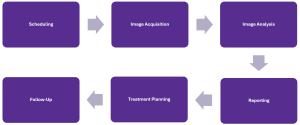
Written by

Cranfield, UK, 6th February 2024 – Most commercially successful vendors within the medical imaging AI market have targeted the image analysis component of the radiology chain (see figure below). This is unsurprising, as image analysis represents the proportion of the chain where most clinical impact can be asserted, opening the doors to impacting clinical guidelines, gaining reimbursement and improving patient outcomes.
However, image analysis AI is yet to experience widespread adoption, with a recent Sermo survey highlighting that out of 100 healthcare decision makers, only one quarter reported they had implemented AI. One barrier to the lack of adoption is the absence of real-world evidence demonstrating health-economic benefits to support a return on investment for providers.
One way in which AI ISVs could look to increase adoption is by provision of AI that influences other parts of the radiology service line, for example during image acquisition, such as patient positioning, quality assurance and supporting faster scan times. Tackling these aspects could enable AI ISVs to build evidence of real time savings beyond the analysis component, which in turn could help alleviate the issues of radiologist shortage and burnout. However, with a diverse range of vendors operating in many of these markets, there is an added layer of complexity AI ISVs must navigate to ensure they create value.
With a customer push towards more comprehensive solutions within the medical imaging AI market, providing capabilities beyond image analysis to drive additional value will be attractive for many AI ISVs. Vendors may choose to develop natively or partner with existing incumbents in adjacent markets; both coming with their separate challenges. This insight explores how AI ISVs can look to target additional aspects of the radiology service line, discussing key examples.

Figure 1. The broader radiology chain in which AI could be used.
Reporting
Today, results from AI solutions are most often reported and presented as structured, DICOM tagged reports, or in PDF format. This adds more elements to an already imperfect reporting process in radiology, including a combination of automated, semi-automated and free-form reporting, which also varies by scan type, setting and geography. Reporting today can therefore limit accessibility and actioning of downstream clinical and operational actions, while increasing the risk of human error amplified by staff burn-out, due to the necessity of manually entering quantitative measurements and free-form text into the radiologist’s report. Providing an automated reporting solution alongside image analysis AI tools would significantly increase the value proposition, delivering significant time savings and improving radiologist productivity and reporting accuracy.
Annalise.ai is one such vendor that has targeted this approach, releasing Annalise Reporting to provide pre-filled, editable draft reports ready for radiologists to review and sign off. However, many challenges present for AI ISVs targeting this route, including the deep level of technical integration required to ensure the results display directly in the radiologist’s preferred viewer. The question also arises as to where AI vendors’ own reporting solutions for their dedicated solutions fit into the wider ecosystem, with the likes of Nuance and 3M (recently rebranded Solventum) dominating the radiology reporting market.
AI ISVs must also consider the comprehensiveness of their imaging analysis AI solutions to ensure the completeness of the radiology report: if only 10 findings can be detected out of a possible 50, the radiologist will have to edit the radiology report regardless. In the future, draft reports will become more accurate providing fewer edits for radiologists and will look to bring in prior scans to aid radiologist reporting.
AI ISVs should not underestimate the complexity of the radiology reporting challenge, nor the nuances and potential impact. Commonly under-appreciated is also the direct consequence of new technology on radiology practitioners themselves. Reporting is viewed as the fundamental and primary role of radiologists, so transformation is not just a technical exercise, but a change to how radiologists carry out their work, which comes with it a whole host of debate and persuasion.
Scheduling follow-up for incidental findings
There are a growing number of AI solutions targeting incidental findings on scans, typically missed in routine reading. Examples released recently include incidental pulmonary embolism and breast arterial calcification from CT scans. However, a recent paper published in JACR demonstrated that almost half of patients did not receive a follow-up when incidental CT-detected breast findings were discovered. As radiologists are not tasked with closing the downstream care loop to ensure their recommendations for follow-up are pointed out directly to patients or seeing that the patient completes the recommended follow-up care, AI ISVs could provide solutions to ensure the correct steps are taken, or at least alert providers that action is required.
One vendor taking this approach is Rad AI with its Rad AI continuity solution, which provides a closed loop for follow-up recommendations for significant incidental findings. The vendor was recently selected by Virtua Health to track and manage incidental findings across the health system in New Jersey. AI ISVs could look to partner with such vendors to provide these capabilities to providers, or AI ISVs boasting end-to-end solutions could ensure that these types of follow-up care recommendations are prioritised. This will increase the value proposition of vendors’ incidental findings solutions, enabling them to provide maximum benefit to patients.
While incidentals offer an apparent “low hanging fruit” for AI ISVs, vendors should also be wary of the wider market context and challenge that incidental detection and alerting can provide. Few healthcare providers have adequate resources to handle existing care requirements, so some providers will be wary of the extra “load” that incidentals may put on health systems. Further, little has been outlined from payers in terms of how incidentals will fit into existing reimbursement and funding for care provision. From a top-down view, the potential of actioning incidentals provides a clear driver towards earlier prevention of disease and better care management for patients, yet there has been very limited evidence of the long-term health outcome or economic impacts at scale of incidental detection. Even more broadly still, especially in private payer markets, debate around the ethics and availability of preventative and earlier detection have a very long way to run. Consequently, AI ISVs should thoroughly review go to market strategy and assess potential barriers ahead of market entry.
Treatment planning
Another area in which image analysis AI ISVs could look to target is developing solutions that enable clinicians to track therapeutic responses and provide personalised treatments for patients. Personalised treatment reduces trial and error prescribing and provides greater control over healthcare costs. For example, Quibim has recently partnered with Merck to explore how to harness the potential of biomarkers and radiomics to predict a cancer patient’s response to immunotherapy and anticipate outcomes. The vendor also previously partnered with Philips, providing QP-Prostate alongside Philips’ MRI imaging, to provide personalised treatment. As advances in genomics, metabolomics and proteomics proliferate and personalised treatment becomes expected, AI ISVs will find success in targeting these types of partnerships due to the ability to improve the long-term outcomes of patients.
Moreover, such partnerships can also help to “de-risk” tool development, with large pharma companies often acting as a commercial “sponsor” in partnerships, thereby providing a commercial leg-up for AI ISVs in the riskier phase of product development and early market deployment. This type of partnership has other benefits too, namely increased brand credibility and the potential to leverage the operational scale and distribution resources of a large pharma or healthcare technology partner. However, AI ISVs should also be wary of the “high risk, high reward” basis of pharma partnerships, especially if deploying substantial resources to support new initiatives, with many co-development projects ending with no tangible commercial offering. Firms should predominantly look to focus on partnership in applications most aligned to commercial clinical image analysis capability, thereby helping to ensure success in therapeutics directly correlates and positively reflects with its core portfolio and products.
Conclusion
With the heat turning up on AI ISVs as funding tightens and many have yet to realise significant revenues, some vendors are looking beyond their image analysis capabilities to prove ROI, targeting additional sections of the radiology service line. Vendors can look to develop these capabilities natively, for example ClariPi and Cerebriu providing image acquisition support capabilities or form strategic partnerships with vendors that provide validated and trusted solutions. However, while this may appear as a quick win, longer-term there is a risk of AI-tools being commoditised unless enough value can be demonstrated to justify providers paying for more AI offerings. Additionally, vendors must ensure that these types of solutions do not decrease efficiency; new offerings should not take longer and force more of a burden on the workflow of radiologists. One way this can be overcome is the tight integration of such solutions with the PACS and RIS to ensure an efficient user experience. Overall, the current landscape sees healthcare organizations looking to optimise their operations in the radiology department to tackle unprecedented staff shortages and burnout; AI ISVs can take this opportunity to expand their capabilities beyond image analysis to improve patient care but should be wary of the challenges and complexities that come with entering the wider radiological context.
Related Research
AI in Medical Imaging Market Intelligence Service
This Market Intelligence Service provides regular data, strategic insights, and in-depth analysis on the global market opportunity for AI-based medical image analysis.
The four deliverables included in the 2024 subscription are:
- AI in Medical Imaging World Market Analysis 2024 – Core Report – June 2024
- Competitive Ecosystem – Topical Report – October 2024
- RSNA Show Report – Show Report – December 2024
- Vendor Sentiment Index – Topical Tracker – Published Quarterly
About The Author
Ellie joined Signify Research in 2023 as part of the Medical Imaging team. She holds a BSc in Biomedical Sciences from the University of Bath and an MSc in Clinical Drug Development from University College London.
About the AI in Healthcare Team
Signify Research’s AI in Medical Imaging service provides expert market intelligence and detailed insights for several of the leading AI and Imaging IT vendors. Combining primary data collection and in-depth discussions with industry stakeholders, our thorough research approach yields credible quantitative and qualitative analysis, helping our customers make critical business decisions with confidence. Furthermore, our commitment to seeking a plurality of perspectives across the markets we cover guarantees that our insights remain independent and balanced.
About Signify Research
Signify Research provides healthtech market intelligence powered by data that you can trust. We blend insights collected from in-depth interviews with technology vendors and healthcare professionals with sales data reported to us by leading vendors to provide a complete and balanced view of the market trends. Our coverage areas are Medical Imaging, Clinical Care, Digital Health, Diagnostic and Lifesciences and Healthcare IT.
Clients worldwide rely on direct access to our expert Analysts for their opinions on the latest market trends and developments. Our market analysis reports and subscriptions provide data-driven insights which business leaders use to guide strategic decisions. We also offer custom research services for clients who need information that can’t be obtained from our off-the-shelf research products or who require market intelligence tailored to their specific needs.
More Information
To find out more:
E: enquiries@signifyresearch.net
T: +44 (0) 1234 986111
www.signifyresearch.net
